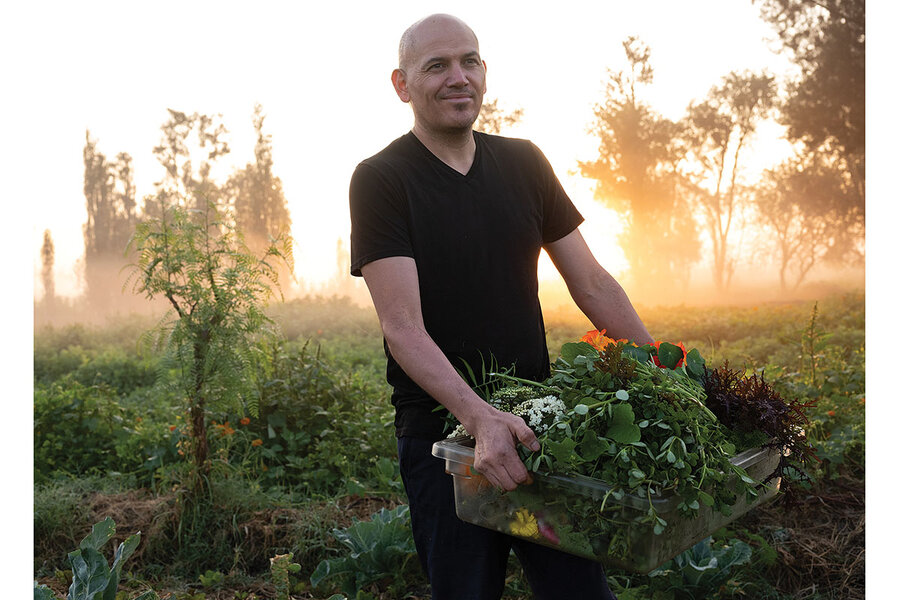A chef’s story reflects US-Mexico border tensions
Loading...
Journalist Laura Tillman was on the trail of a different story in 2016 when she called Máximo Bistrot, a fine dining restaurant in Mexico City. She wanted to learn more about the experiences of the cooks, servers, and dishwashers who served Mexico’s elite amid the nation’s widening wealth gap. But when chef Lalo García came to the phone, he offered her something else: his experiences of midnight border crossings, migrant field work, imprisonment, deportation, and an unprecedented rise from being a dishwasher in Atlanta to becoming one of Mexico’s most respected culinary talents.
“I had no idea that Lalo was at a critical moment in his life,” Tillman writes in “The Migrant Chef: The Life and Times of Lalo García.” “Mexican immigrants were increasingly being used as political pawns during the U.S. presidential election, and Lalo wanted to share his story.”
In the book, Tillman pieces together García’s life from interviews, hours spent in his restaurant kitchen, and detailed research. She places his narrative arc within a geopolitical and historical framework to help readers understand the complexity of the ties between the United States and Mexico and the lives of the people who cross between the two countries.
García’s grandfather began migrant work under the Bracero Program, which permitted Mexican men to work in the U.S. on short-term contracts. Years later, after Bracero ended, García’s father, Lupe, started migrant farm work and was eventually able to earn a green card under President Ronald Reagan’s amnesty for agricultural workers. García was still a boy when he joined his father on the trail from rural Mexico to work on farms between Florida and Michigan, gathering fruit as the seasons flowed from April to November. As a teenager, after his family had settled in Georgia, García turned to restaurant work. His dexterity and speed honed in the fields shone while washing dishes and prepping food, earning accolades from cooks and gradually securing his place on the line. He earned enough money to buy fashionable clothes and a brand-new Mustang. But in a moment of youthful impetuosity, he drove the getaway car for a robbery and was caught. After serving a prison sentence, he was deported to his grandparents’ home in Mexico.
But García, then in his early 20s, soon crossed illegally back into the U.S. when his father’s health failed, and resumed his restaurant work. Tempered by his time in prison, he threw his creative energies into a career in food. He deepened his relationships with his employers and co-workers, and fathered a son, Max, with a girlfriend. Eventually, he rose to head chef of a respected Atlanta-area restaurant. When the restaurant owners opened a new taqueria with García at the helm, for the first time he had agency to re-create flavors of his childhood: freshly made salsas, tamales, chilaquiles, and enchiladas. When immigration authorities tracked him down seven years after crossing back into the U.S., this time his exile to Mexico was final.
But García’s story doesn’t end there. After a struggle to find his place, he became an influential chef in Mexico City at a moment when his peers were using techniques of French and Italian cuisine to elevate Indigenous dishes. He inspired and trained a new generation of world-class Mexican chefs who flourished locally. He partnered with and married a woman who matched his creative visions in business and life. He traveled abroad to study and learn new techniques all the while opening upscale restaurants, naming one of them Máximo Bistrot after the son he no longer knows. Ultimately, García’s story of persistence, hard work, failure, and success presents a more nuanced portrait of unauthorized Mexican workers seeking a better life.
In “The Migrant Chef,” Tillman makes visible the hidden labor of upscale restaurant workers through the thin swinging kitchen door that separates them from the elite clientele they serve.
Whether or not you travel to Mexico City to sample García’s creations, reading his story brings humanity, empathy, and understanding to the issue of the U.S.-Mexico border and the people and ideas traversing it.
Editor’s note: This article has been updated to correct which family member worked under the Bracero program.









